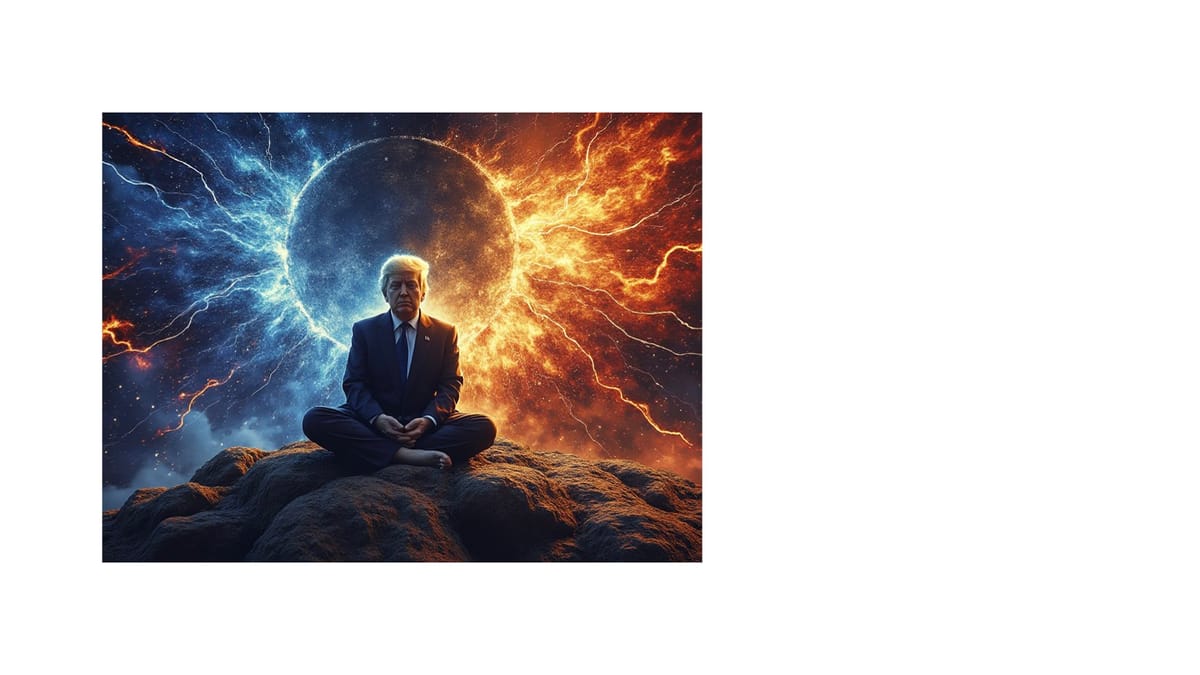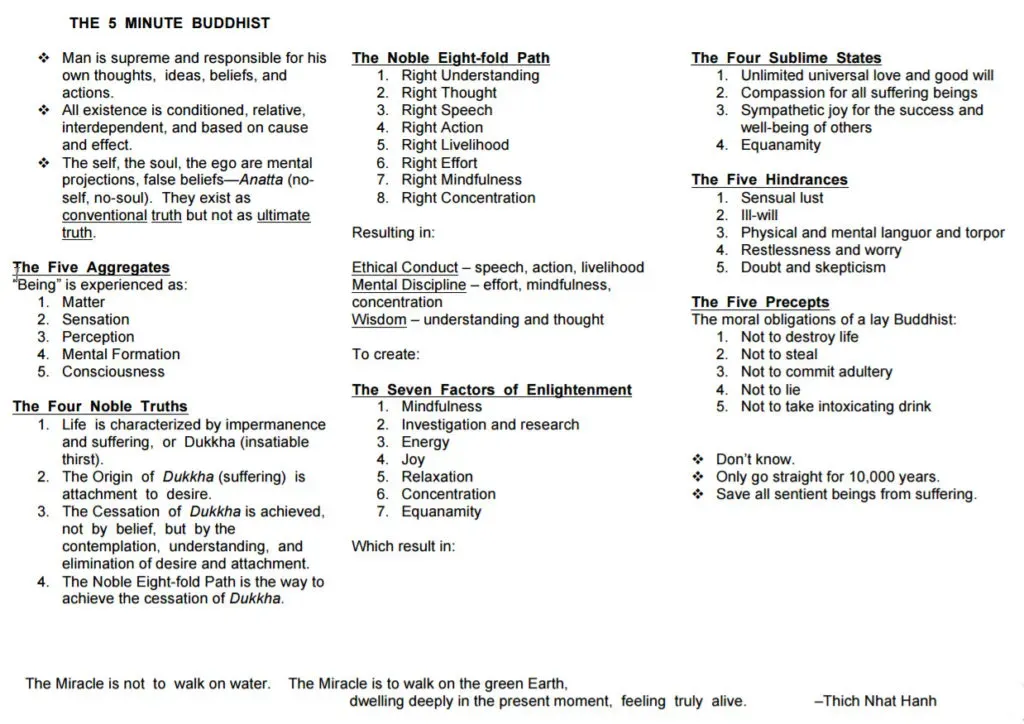Notes: BTD and Other Discontents
"Buddhist Trump Derangement (BTD)", The Hegelian Trap, And Learning to Sit with Fear

Trump and Kamala’s current head-to-head dance flashes me back to 2016.
The scene—the Trump victory still fresh, and meditation groups, unraveled into hours of speeches, dharma talk sessions brimming with despair, and newsletters demanding "immediate attention." The atmosphere in my local Buddhist Sangha 1 collapsed into disarray. Years of training failed to hold back the wave of fear. Group sittings were canceled, open mics filled with elderly Buddhist atheists wearing purple sharing sob stories of weeping in the aisles of stores over organic pears, overwhelmed by the imagined fascist wave to come. They spoke of moving to Canada. Their fear too large to contain, spilling out into chants and moralizing speeches—team X over team Y. Derailment I thought.
Can we come back to the actual work? To the breath? To the rhythm of in and out, not what "Daddy Trump" said or “dog whistled” to. Distraction. Back to the present. Is your back straight? Do you feel the tickle in your knee? Observe it, and it will vanish. Breathe in. But no — two hours of meditation group time, instead spent fostering a panic over Trump's evil. I tried to just sit and observe, to not judge the derangement. Eight years later, the same circle has formed again. Biden's rule now celebrated in the sanghas, that Kamala’s “joy” is the only way to stop the fascism of Trump’s potential return. An insular panicking worldview. Focus on the breath, I try to focus not on the staged clown show.
The derailment mirrors the personal challenge- the political fear and ideological attachment, exacerbated by the external have again infiltrated Buddhist and spiritual circles, derailing practitioners from mindfulness, non-attachment, and self-awareness. By succumbing to fear, moral superiority, and external divides, these communities and I would argue the personal contradict the core teachings—focusing on the present, cultivating inner calm, and detaching from worldly ideologies.
From friends, I hear that their churches, synagogues, and sacred halls have always been divided along political lines but even more so now. Wars rage across the globe, but in the dharma halls of all creeds, the panic centers around these shallow earthly splits. The same performance repeats, whether in the U.S. or abroad. In Chile, my sister tells me that her meditation group had fractured over technical constitutional reform debates. No one in the US even knew that 14 million Chileans split evenly, ready to knife each other’s throats, labeling each side in the schismogenesis 2 : communist/fascist as was the dynamic dance in the polarizing mirror. The schisms spread, breaking communities, all under the banner of "democracy dying in darkness." In the Middle East, the story is the same—raging battles consume and divide. Even meditation masters falter. An arrow finds gaps in their armor.
One of my teachers, often spoke of "sitting with fear." Fear is useful for the state, the guru, for Mommy and Daddy. The child fears the parental state, but love—love is the greater force. Settle into fear, whether it’s solar flares, 5G, vaccines, COVID, Putin, or Trump. Settle into the unknown. But he also reminded us to be cautious, for gurus too can use fear as a tool, guiding you back into dependency. Christianity offers celestial frameworks, while Buddhism teaches us that all existence is conditioned and relative—cause and effect. There is no conventional truth, only ultimate truth. Observe. Watch the mental formations arise and dissipate.
COVID was the ultimate mind trip. Years of distrust in Big Pharma dissolved as the faithful lined up for the latest metaphor of salvation. The teachings of Buddha, the warnings against shiny objects, were forgotten. Masks, vaccines, and the exclusion of the unvaccinated became the new fascism split within circles—the fascism of purity, of control. Zen, once radical, bent toward the state. Hatred of Trump seemingly forgotten, as they lined up for the Warp Speed-enabled vaccine he had supported.
I recall reading about Zen and fascism in Imperial Japan. I saw it firsthand during COVID. Kicked out of a sangha for not receiving the sufficient number of pharmaceutical products in my blood stream, proof to others of lack of faith in their “faith”. The state played on the group mind, softening and steering. Fear makes all malleable.
Before the lunacy of COVID and Trump, earlier, once I sat in a Zen group, and the priest asked, “Where did you learn to sit?”. I replied, “No, no, I’m still a beginner. I’ve been only doing vipassana 3 for 20 years”. To my surprise, they asked me not to return. No “Buddhist buffet” allowed. You must commit to to this type of Zen practice they said to sit here. More lunacy. More cult dynamics. I thought, cross-training, as UFC fighters do with judo, boxing, and wrestling, is essential for growth. But not here. In this Buddhist circle, vipassana practitioners were unwelcome. Another divide, another schism.
Solo, sampling from the Buddhist buffet, I focus on my daily practice: metta, gratitude, and the Eightfold Path. I remember the Four Noble Truths. Simple. Ignore the material, focus on the immediate. A Bible verse illuminates too—John 1:5: "The light shines in the darkness, and the darkness has not overcome it." I try to remember the beginner’s spirit.
An Argentine friend of mine, a studio ceramicist, was at her wheel when her American colleague interrupted. “Man, Milei won, another Trump down in Argentina—what’s the world coming to?” My friend didn’t engage. She returned to her work, letting others sit with their fears. She didn't need to label, or categorize. Trump derangement syndrome spans borders. Civilizations rise and fall, like the breath, like the turn of her pottery wheel.
I think of the famous atheist mindfulness teacher Sam Harris, whose meltdown over Trump alienated his former allies, Joe Rogan and Bret Weinstein. Their algorithm driven alliance known at the Intellectual Dark Web dissolved into factions. All playing parts in the Hegelian sideshow—thesis, antithesis, synthesis. But the breath remains constant, a cycle of each moment. Breathe in, breathe out. We cannot control external events, only our reactions. All this training, all these distractions, are mere lessons to return to the present moment.
A friend shared evidence that Tibetan teachers were recruited by the CIA 4 to destabilize China, casting doubt on Tibet’s struggle narrative. Another told me of his guru who embezzled millions; I read about another who abused his followers. And yet, despite the false starts and betrayals, the practice remains unshaken if you can hold onto the core. Eyes open or closed, just sit. Focus on the moment. Soft front, strong back. Breathe. Everything else is chatter—miscommunication, psychological operation, delusion. Through awareness of the present moment, we cultivate a calm, focused mind. In that stillness, a tiny gap opens—a fleeting glimpse of the infinite. Insight flashes briefly, then disappears. But in that moment, we find harmony amid life’s contradictions. And perhaps, in that gap, with the right attitude and clarity of mind, we begin to understand what should or might be done.
The hardest truth to remember is we don't know. Certainty eludes us, yet love—universal love—remains constant. Trump, Biden, Xi, Putin, Pinochet, Mao, Hamas, the IDF—your anger, your rage, your confusion—all dissolve in the face of this truth. The first step is to sit in love. Full breath in, full breath out. Soft belly, strong back. Neither attachment, nor aversion. And as Rinzai5 whispers as a reminder: "If you meet the Buddha on the road, kill him."
In the end, the lesson is to sit with fear, as my teacher once said. But more than that, we must learn to observe fear without letting it consume us. The true practice of Buddhism, or any spiritual path, is not to escape the world but to engage with it from a place of detachment and love. If we cling to ideologies, whether spiritual or political, to an individual or an ideology we are lost in delusion. It is only through mindfulness and presence that we can find the clarity to navigate this chaotic world with compassion. And perhaps, in doing so, we might just glimpse a deeper way.

1:
One of the three “Jewels” in Buddhism.The Sangha Jewel encompasses the community of Buddhist practitioners, including monastics and laypeople. It signifies the support, inspiration, and collective effort that arises from gathering others to cultivate the path.
2:
Coined by anthropologist Gregory Bateson in 1935, Schismogenesis describes how we define ourselves through escalating differences or similarities. It's a feedback loop where each iteration amplifies the last, shaping our identity in relation to others.The term derives from the Greek words σχίσμα skhisma, “cleft,” (borrowed into English as schism), and γένεσις genesis, “generation” or “creation.” See: https://batesoninstitute.org/gregory-bateson/
3:
Vipassana meditation, in its essence, predates Buddhism. Vipassana, which means "insight" or "clear seeing" in Pali, refers to a type of meditation that aims at seeing things as they truly are. While it is most closely associated with the teachings of the Buddha, the roots of this practice can be traced back to earlier meditation techniques found in the Indian contemplative tradition.
4:
Deep Rabbit Hole for you to jump into: “Status Report on Support to the Dalai Lama and Tibetan Operations":
CIA Tibetan activities, utilizing followers of the Dalai Lama, have included in addition to guerrilla support a program of political, propaganda, and intelligence operations. These activities are designed to impair the international influence of Communist China by support to the Dalai Lama and the Tibetan exiles in maintaining the concept of an autonomous Tibet See CIA Documents: https://www.cia.gov/readingroom/docs/CIA-RDP79R00890A001100070008-0.pdf or even from Wikispooks “https://en.wikipedia.org/wiki/CIA_Tibetan_program” - Current status classified.
5:
Rinzai's warning is clear: do not become attached to doctrines, symbols, or any form of idolization. Clinging to an image of the Buddha or Trump—or any political figure or group—ensnares you in delusion and derangement. True spiritual insight arises from within and cannot be found in external representations or fixed ideas. "Killing the Buddha" is about breaking free from attachment to authority, dogma, or preconceived notions, in the pursuit of the present moment’s truth. It's a difficult path, but one that maybe leads to clarity and understanding, unbound by the limits of ideology.